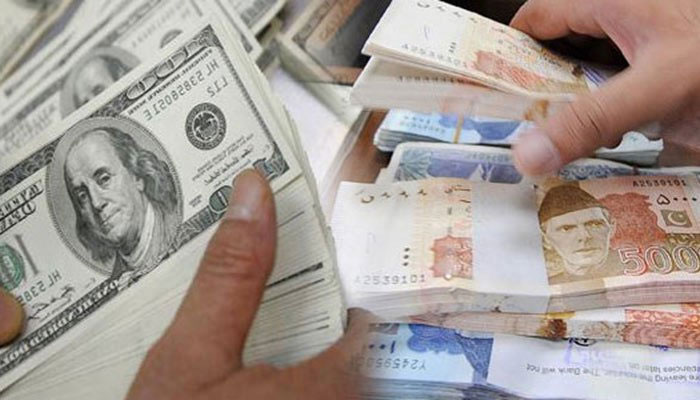Rupee loses 7.87pc in three months
KARACHI: Rupee lost 7.87 percent against the dollar during the first 100 days of the new PTI government, as depleting foreign currency reserves coupled with a widening current account deficit weighed on domestic currency.
The currency was also under pressure in the open market, and declined as much as 9 percent against the dollar in the kerb market.
This slide began on August 20, following Imran Khan’s swearing in as Pakistan’s Prime Minister on August 18, 2018. By late August, rupee was hovering at 124.24/dollar.
On Tuesday, the official interbank rate closed at 134.04/dollar and 135.40 in the open market.
The PKR, which cemented its position as the worst performing Asian currency during the previous fiscal year, suffered a major setback last month.
It saw a sharper 7.5 percent single-day depreciation on October 9 amid rising external pressure on the economy. Resultantly, the currency fell to 133.64 against the dollar.
The State Bank’s moves to hike the policy rate by 100 basis points to 8.5 percent in late September also did not prove to prevent the currency from further decline.
Most analysts agreed that the devaluation was unavoidable on the part of the central bank to curb hefty imports fuelled by higher domestic demand. “The State Bank of Pakistan did market-driven adjustment in the exchange rate as the country had not enough forex reserves to support the rupee. So, the devaluation was based on the demand and supply mechanism. It was necessary to preserve the foreign currency reserves,” said Dr Salman Shah, former caretaker finance minister.
The SBP’s foreign reserves declined to $7.286 billion in the week ended November 16 from $9.885 billion in August 2018. The reserves were sufficient to pay less than two months of imports.
The country’s economy has been shaky for the last few months, prompting the government to approach the International Monetary Fund and some friendly countries for financial help to avert the balance of payments crisis.
The prime minister’s visit to Saudi Arabia last month yielded positive results, as the country managed to secure $6 billion in loans and deferred-payment deals on oil.
The central bank received $1 billion on November 19 as placement of funds by Saudi Arabia. These inflows offered some support to the SBP’s reserves which rose to $8.293 billion. China also pledged to support Pakistan’s economy during the premiere’s visit to the country this month. However, the nature of the Chinese financial assistance is still unclear.
Pakistani government held negotiations with the IMF mission from November 7-20, 2018 to initiate discussions on a financial arrangement to support its economic reform programme. However, the government was unable to reach an immediate agreement with the fund over a bailout package due to some tough preconditions set by the IMF.
One of the major conditions asked by the Fund is to pursue a free-float exchange rate, instead of managed exchange rate.
Dr Slaman Shah said the IMF wants more exchange rate flexibility.
“It calls for zero intervention from the central bank in the currency market. It [IMF] wants market forces to determine the movement of the exchange rate.”
Analysts remain bearish on the Pakistani rupee as the currency is likely to remain under downside pressures.
The rupee is expected to depreciate to as low as 140-145 per dollar by December and January 2019 if the country manages to secure the IMF’s financial support.
Further depreciation of the rupee will run the risk of triggering external debt servicing obligations. Foreign debt and liabilities increased 10 percent to Rs12.72 trillion in response to last month’s currency adjustment. The current account deficit fell by 4.57 to $4.840 billion during July-October 2018/19, compared with $5.072 billion in the same period last year.
Dr Shah believes the rupee would hold the present levels if the foreign inflows, including foreign direct investment, increased and current account deficit narrowed.
-
 Elizabeth Hurley Faces An Impossible Choice As Son Damian, Beau Billy Ray Cyrus Clash
Elizabeth Hurley Faces An Impossible Choice As Son Damian, Beau Billy Ray Cyrus Clash -
 Rare Pokémon Cards Worth $100k Stolen In New York Shop Robbery
Rare Pokémon Cards Worth $100k Stolen In New York Shop Robbery -
 Chevy Chase Shares Disappointment After 'SNL50: The Anniversary Special' Snub
Chevy Chase Shares Disappointment After 'SNL50: The Anniversary Special' Snub -
 Samuel L. Jackson's Old Movie Found New Life: Here's How
Samuel L. Jackson's Old Movie Found New Life: Here's How -
 Nobel Prize Snub Hardens Donald Trump's Tone On ‘peace’
Nobel Prize Snub Hardens Donald Trump's Tone On ‘peace’ -
 What's Prince Harry's Case Against The Daily Mail's Publisher?
What's Prince Harry's Case Against The Daily Mail's Publisher? -
 'Matilda' Star Mara Wilson Breaks Silence On AI's 'deepfake Apocalypse' After Being Abused
'Matilda' Star Mara Wilson Breaks Silence On AI's 'deepfake Apocalypse' After Being Abused -
 Meghan Markle 'ruined' Prince Harry's Life?
Meghan Markle 'ruined' Prince Harry's Life? -
 Super Bowl Halftime Show Gets Another Attraction Besides Bad Bunny
Super Bowl Halftime Show Gets Another Attraction Besides Bad Bunny -
 Princess Irene's Coffin Arrives For Funeral Rites
Princess Irene's Coffin Arrives For Funeral Rites -
 Sean Penn's Gay Role Interview Resurfaces After LA Stroll With Valeria Nicov
Sean Penn's Gay Role Interview Resurfaces After LA Stroll With Valeria Nicov -
 FBI’s Most Wanted Caught After 10 Years In Mexico
FBI’s Most Wanted Caught After 10 Years In Mexico -
 Inside Kate Middleton's Meaningful Nod To Own Milestone
Inside Kate Middleton's Meaningful Nod To Own Milestone -
 Zachary Levi 'running' To Build His Future In Politics?
Zachary Levi 'running' To Build His Future In Politics? -
 Andrew Lands In Fresh Major Trouble After Princess Eugenie Left Him 'devastated'
Andrew Lands In Fresh Major Trouble After Princess Eugenie Left Him 'devastated' -
 Colleen Hoover Shares Major Update About Cancer Treatment
Colleen Hoover Shares Major Update About Cancer Treatment




